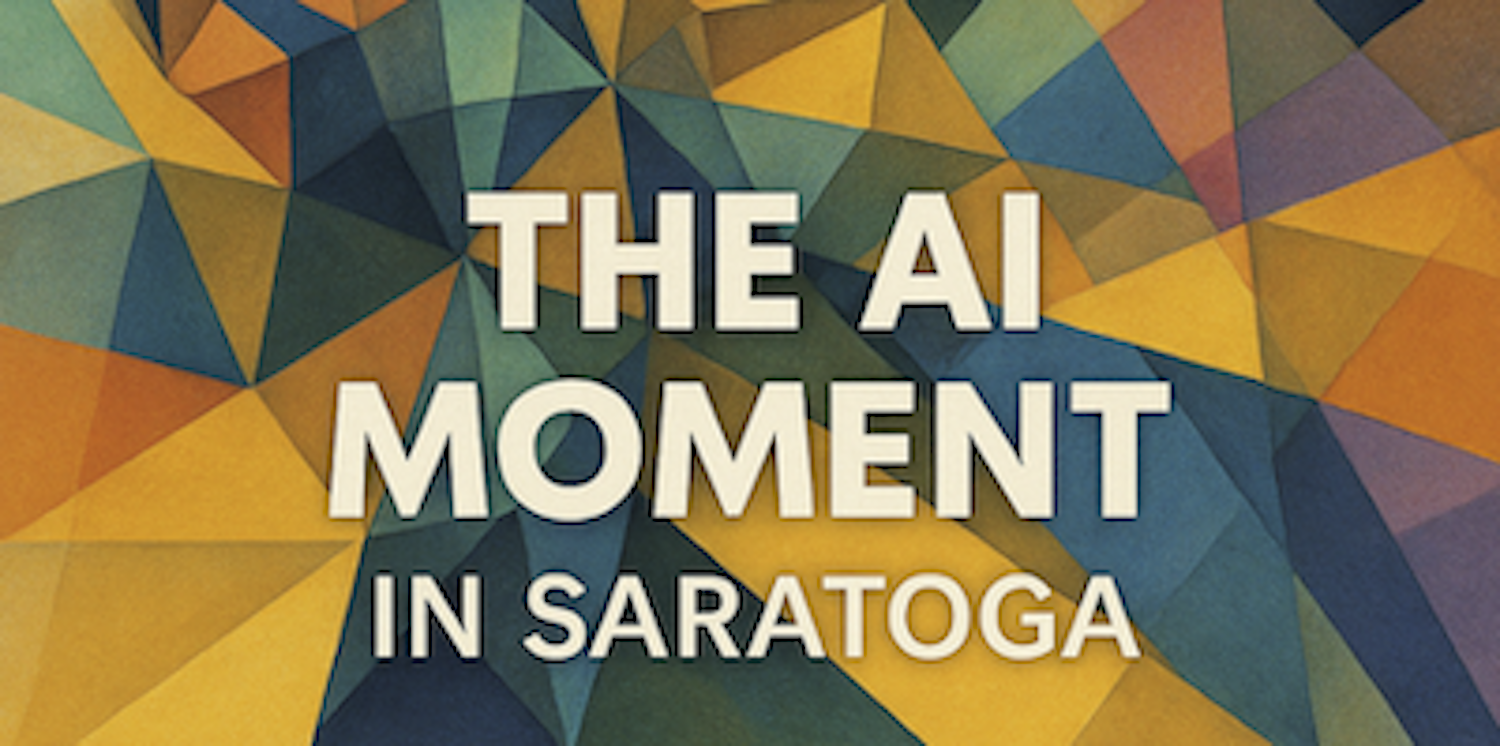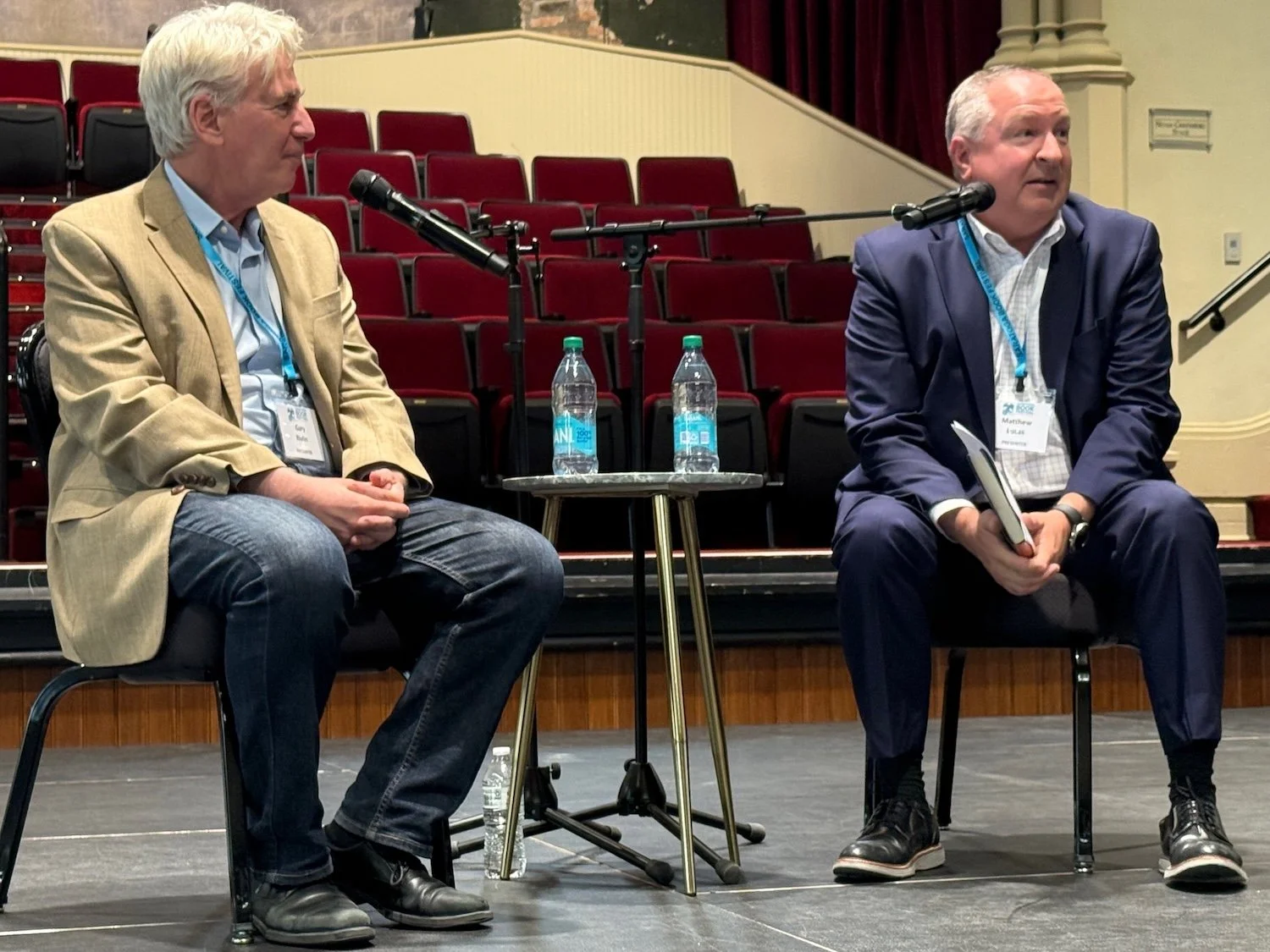Opportunities and Challenges in AI Development
20 Takeaways from the Saratoga Book Festival
The following lists of Top Ten Opportunities and Top Ten Challenges in Artificial Intelligence were distilled from three illuminating conversations offered October 5 at the Saratoga Book Festival.
Using NotebookLM and ChatGPT in tandem, we created a workflow that allowed us to capture each session in full, analyze every theme and quote, and synthesize the core insights into two coherent frameworks: one of promise, one of peril. This is a new way of “mining” expert knowledge that AI makes possible.
The three discussions—Sam Rad and the Art of Freefall, AI for Creatives, and What Comes Next?—featured six primary voices: Samantha Radocchia, Gary Rivlin, Matt Lucas, Sarah Sweeney, Mason Stokes, and Robert Lippman, Esq.
Working from their recorded panels and transcripts, we imported the material into Google’s NotebookLM, where it could be indexed, summarized, and cross-referenced by topic and theme.
From there, we used ChatGPT to refine the structure and language—preserving the panelists’ exact words while distilling recurring insights into concise, four-sentence summaries that balance technical accuracy with narrative clarity.
The result is a panoramic view of AI’s dual nature: its capacity to elevate human creativity, collaboration, and moral reflection, and its potential to destabilize the social, economic, and ethical systems that hold civilization together.
Together, these twenty entries reveal a moment in human history defined not only by rapid technological transformation but by the urgent need for collective wisdom. As the experts gathered in Saratoga reminded us, the question is not whether artificial intelligence will change everything, but whether we can evolve our institutions, laws, and imaginations quickly enough to meet the challenge.
Top Ten Opportunities
Sarah Sweeney, Mason Stokes and Robert Lippman
Scalable Problem-Solving for Complex Systems. From medicine to climate modeling, AI’s capacity to process vast data sets gives humanity new power to confront global challenges. When used responsibly, these systems can reveal solutions hidden within overwhelming complexity. The key is coupling computational insight with human oversight to ensure beneficial outcomes. As Gary Rivlin cautions, “AI can accelerate science, education, and healthcare—but also amplify bad actors. We need guardrails that make a net positive more likely.”
Institutional and Societal Redesign. AI’s disruption of outdated systems opens a window to rethink the architecture of education, governance, and economics. The task is not to retrofit 20th-century institutions but to build adaptive, ethical frameworks for a rapidly changing world. This redesign can embody cooperation, transparency, and distributed intelligence. As Radocchia envisions, “Instead of a ‘flat chessboard’ of rigid hierarchies, I imagine a living, multidimensional system guided by cooperation.”
Augmented Human Creativity and Collaboration. AI is becoming a creative partner rather than a replacement, serving as a kind of “smart editor” that accelerates process, sparks inspiration, and extends human reach. Writers and artists now use generative systems as mirrors that challenge them to refine their voice and push artistic boundaries. The result is a new form of co-authorship in which the human defines meaning while the machine expands possibility. As Mason Stokes observes, “I’ve found AI to be a useful interlocutor—a conversational partner … It knows my work better than most of my friends.”
Democratized Access to Tools and Expertise. Powerful AI systems once limited to major corporations are now available to individuals, small businesses, and classrooms, flattening hierarchies of innovation. This democratization allows anyone with curiosity and a connection to participate in complex problem-solving and creative experimentation. The shift mirrors earlier revolutions in printing and computing—making intelligence itself a shared utility. As Matt Lucas notes, “We’ve reached the point where these tools are part of everyday life.”
Enhanced Learning and Skill Development. AI-powered tutors, simulators, and editors can accelerate human learning by providing personalized feedback and infinite practice opportunities. Early-career professionals now have access to mentorship and refinement once reserved for elite institutions. These tools can democratize education and nurture creativity when integrated thoughtfully and ethically. Mason Stokes reflects, “As writers and teachers, I’m intrigued by the opportunities AI presents, even as I recognize its risks.”
Samantha Radocchia
Amplification of Human Judgment and Values. As machines take over repetitive tasks, the uniquely human capacities for ethics, empathy, narrative, and meaning become more valuable. The integration of humanistic disciplines into AI design is necessary to ensure that technology reflects—not replaces—our collective conscience. This opportunity invites collaboration among scientists, philosophers, and artists to encode human values in the systems that shape society. Gary Rivlin insists, “We need diversity of people and disciplines—historians, philosophers, sociologists, activists—alongside computer scientists.”
New Economic and Professional Models. While some jobs will disappear, others are emerging at the intersection of art, technology, and ethics. Hybrid roles—prompt engineers, data curators, AI ethicists—illustrate how work can evolve toward more creative and strategic forms. These transitions invite societies to design fairer systems of value, education, and compensation. Gary Rivlin predicts, “Over time, AI will create new roles."
New Forms of Artistic Expression. AI offers artists new materials and methods, blending language, sound, and image in ways no previous medium could achieve. Hybrid human-machine art challenges our definitions of authorship and intimacy, creating emotionally resonant experiences that cross the boundaries of memory and imagination. The encounter between artist and algorithm becomes an exploration of what creativity itself means. Sarah Sweeney illustrates this with her experiment in AI voice-cloning: “My current project … uses AI to recreate my father’s voice. The process is intimate but unsettling.”
Human Agency in Shaping Machine Collaboration. AI presents an opportunity for creators to assert control over how technology interacts with their work and values. Instead of being passive subjects of automation, artists and educators can establish the rules of engagement, ensuring that machines serve human intention. This shift reframes creativity as a negotiation rather than a surrender. Sarah Sweeneyemphasizes, “Artists should decide how their work interacts with machines, not have that decided for them.”
Reclaimed Human Connection and Time for Meaning. By off-loading mechanical or administrative labor, AI could free people to focus on presence, empathy, and community. The paradox of intelligent machines is that they may ultimately help us become more human. Used wisely, they can restore time for contemplation, conversation, and care. Samantha Radocchia urges, “Get back in rooms together.”
Top Ten Challenges
Systemic Instability. Society’s industrial-era systems are no longer capable of managing the exponential acceleration of AI-driven technologies. This misalignment between technological power and social resilience leaves economies, information networks, and governments vulnerable to cascading failures. A single algorithmic exploit, deepfake campaign, or data-center failure can now trigger global disruption. As Samantha Radocchia warns, “Our social operating system is outdated. It’s running 21st-century code on 19th-century hardware.”
Gary Rivlin and Matt Lucas
AI Psychosis. The proliferation of synthetic media and persuasive algorithms is eroding humanity’s shared anchor to truth. Deepfakes and AI-generated personas blur the boundary between authentic and fabricated, dissolving collective confidence in what is real. This confusion undermines journalism, governance, and interpersonal trust alike. “The danger,” cautions Radocchia, “is not madness but drift—a society losing its collective anchor to truth.”
Absent Guardrails. AI development and deployment are outpacing the creation of effective ethical and regulatory frameworks. Governments and institutions struggle to define accountability for systems whose inner workings even their designers barely understand. The absence of oversight invites the possibility of catastrophic misuse in finance, health, or biosecurity. As Gary Rivlin warns, “My fear is that real regulation only arrives after a bad event—a biosecurity incident, a massive financial exploit.”
Consolidated Power. A handful of hyperscaler corporations now control the infrastructure, data, and expertise that define the AI frontier. This concentration of resources suppresses open innovation and leaves democratic institutions dependent on private entities whose incentives may not align with the public good. The collapse of smaller players demonstrates how expensive and exclusive the field has become. As Rivlin observes, “The next Google might be Google. Frontier models are so expensive that incumbents have the edge.”
Uncompensated Use. Generative models are built on vast datasets of copyrighted material collected without consent or compensation, undermining the creative economy’s moral foundation. Artists, writers, and musicians find their works repurposed as unpaid training data for systems that may soon replace them. This practice devalues authorship and erodes public trust in the legitimacy of AI innovation. “You’ve named AI’s original sin,” says Rivlin, “models trained on creators’ copyrighted work without compensation.”
Erosion of Expertise. As AI automates entry-level professional tasks, it threatens the pathways by which humans develop expertise and judgment. Lawyers, engineers, and analysts increasingly rely on systems that perform early-career functions once essential for mastery. The long-term result could be professions hollowed out from within. Robert Lippman asks pointedly, “…if those jobs start disappearing, where does the next generation of seasoned attorneys come from?”
Diminished Agency. Outsourcing thought, creativity, and decision-making to machines weakens the muscles of human autonomy. When people rely on AI to generate ideas or interpretations, they risk forgetting how to think independently or take aesthetic and moral ownership of their work. This subtle dependency changes not only what we create but who we become. “What happens,” asks Mason Stokes, “when I can no longer tell where my ideas end and the machine’s begin?”
Loss of Creative Jobs. Automation in the arts and media industries is rapidly displacing human creators, often without safety nets or retraining pathways. Entire categories of work—illustration, copywriting, editing—are being reassigned to models that mimic human output at scale. Companies adopting automation justify it as efficiency, but for workers, it represents profound loss of purpose and income. Sarah Sweeney recounts, “One of my former students told me their company now has an ‘AI-first policy’: if AI can do it, a human doesn’t.”
Infrastructure Strain. Behind every generative model lies an enormous and growing appetite for electricity, water, and rare materials. Data centers now compete with local communities for finite energy and cooling resources, straining grids and ecosystems. The environmental and infrastructural toll challenges the perception of AI as an abstract, weightless technology. As Rivlin remarks, “This is a climate and infrastructure story, not just a software story.”
Copyright Limitations. Current intellectual-property law does not recognize works generated without meaningful human authorship, creating uncertainty for businesses and creators alike. Hybrid works are only protected when human creative input can be clearly demonstrated, leaving AI-assisted art in a legal gray zone. This legal gap discourages experimentation while offering little clarity for courts or policymakers. Lippman explains, “The human contribution must be substantial, demonstrable, and independently copyrightable. A.I. lacks ‘meaningful human creative input.’”




